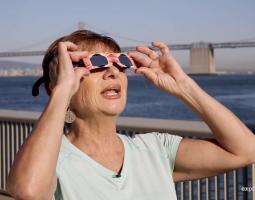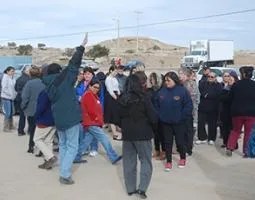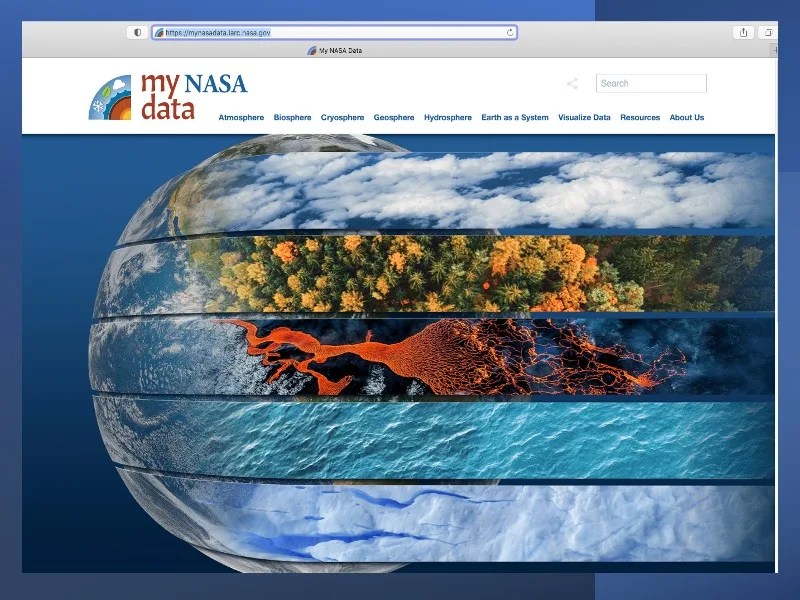Lessons and Activities
- NASA's Our World: Engage your learners with NASA’s Our World videos (grades 3-5) that are aligned with national STEM standards and explore NASA-inspired science (the natural world) and engineering (the designed world) topics.
- Ask SME: Close-up with a NASA Subject Matter Expert: Spark your learners’ interest and broaden their ideas about the STEM workforce by introducing them to Ask SME videos that capture a glimpse of NASA SMEs’ personal interests and career journeys.
- NASA Spotlites: Share these short (90-120 second) student-produced videos with your learners to provoke discussions about science misconceptions.
- Where in the World Interactives: Engage learners with astronaut photographs from the International Space Station to help them build knowledge and skills about features, locations, and the geography of Earth. Learners can earn and personalize their NASA badge after completing each interactive.
- Data Literacy Cube Guide: Engage all learners, including multilingual learners, with differentiated questions to analyze maps, graphs, or data.
- Guide Lites: Explore Guide Lites for streamlined, hands-on activities that support inquiry- and design-based learning for formal and nonformal audiences.
- Carina Mini Data Story: Explore Hubble and JWST images of the Carina Nebula in a virtual sky and learn how astronomers use different types of light to learn about objects in space.
- Green Comet Mini Data Story: Check out the path of Comet ZTF, the “Green Comet,” through the sky, find out why it's green and discover why comet tails point where they do!
- NASA’s Real World: Engage your learners with NASA’s Real World videos (grades 6-8) that demonstrate how mathematics is a tool to solve real-world problems related to NASA-inspired science and engineering.
- Ask SME: Close-up with a NASA Subject Matter Expert: Spark your learners’ interest and broaden their ideas about the STEM workforce by introducing them to Ask SME videos that capture a glimpse of NASA SMEs’ personal interests and career journeys.
- NASA Spotlites: Share these short (90-120 second) student-produced videos with your learners to provoke discussions about science misconceptions.
- Field Trip: Mars Kahoot: Join the American Museum of Natural History on a virtual field trip to Mars, then test your students’ knowledge of the Red Planet.
- Field Trip: Moon Kahoot: Take your class on a virtual journey from Earth, to the International Space Station, to the Moon and beyond, then test your students’ knowledge.
- Where in the World & Classifying Moon Rocks Interactives: Engage your learners with interactives that allow them to work with NASA data including astronaut photos or Earth (Where in the World) or Apollo Moon rocks (Classifying Moon Rocks). Learners pick up fun facts, have options to explore more and can even download and personalize their own badge!
- Data Literacy Cube Guide : Engage all learners, including multilingual learners, with differentiated questions to analyze maps, graphs, or data.
- Our Wonder for the Stars: A virtual field trip to investigate space exploration of the past and NASA’s newest endeavor, James Webb Space Telescope.
- Phases of Matter Visualization: Experiment with temperature and pressure on different planets to create phase change diagrams for water, carbon dioxide, and methane.
- Guide Lites: Explore Guide Lites for streamlined, hands-on activities that support inquiry- and design-based learning for formal and nonformal audiences.
- Solar System Explorer: Explore an accurate online model of our solar system that is based on NASA imagery and other real data. Navigate through space, control time, and explore the Sun, planets, and moons from up close and far away.
- My NASA Data: Use NASA data to understand science phenomena. Resources are organized by Earth system sphere, aligned to Next Generation Science Standards, and scaffolded to provide quick activities through Mini Lessons, longer Lesson Plans, or student facing Interactives. Get started using the faceted search or access the Data Literacy Cube Guide to scaffold data analysis for all learners, including multilingual learners.
- Phases of the Moon: Explore the phases of the Moon in this cool 80's retro style experience featuring an AI friend LuCIA and an immersive simulation designed to fully experience moon phases.
- Eclipses (Part 1) (Part 2) (Part 3): This 3-part series explores the three components responsible for solar and lunar eclipses, planetary body arrangement, size, and inclination, using NASA Eyes on the Solar System visualization engine.
- NSTA Science Scope: Making Science Come Alive with Clouds: Learn strategies from middle school teachers to facilitate student environmental observations of clouds using technology - the GLOBE Observer mobile app.
- Zika Zine: A story of Three Aedes Mosquitoes: Meet Wanda, Hester, and Maurice in the interactive Zika Zine to learn how Aedes mosquitoes live, why NASA is interested in them, and how you can help NASA by documenting mosquito habitats with the GLOBE Observer app. After reading the comic, learners can use How to Draw Wanda in 9 Easy Steps and Make Your Own Zika Zine Comic as templates to create their own pictures and stories using tools as simple as a piece of paper to presentation software.
- Educator Guides: Explore a library of Educator Guides for 5E constructivist lessons that incorporate NASA eClips™ video segments.Spotlite Design Challenge: Help learners research, write scripts and produce short videos to build their own understanding of science concepts through the Spotlite Design Challenge.
- American Museum of Natural History: GRACE Teaching Case: This 4-part teaching case includes passages and accompanying stop-and-think questions that encourage students to investigate NASA’s Gravity Recovery and Climate Experiment (GRACE) mission.
- Where in the World & Classifying Moon Rocks Interactives: Engage your learners with interactives that allow them to work with NASA data including astronaut photos or Earth (Where in the World) or Apollo Moon rocks (Classifying Moon Rocks). Learners pick up fun facts, have options to explore more and can even download and personalize their own badge!
- Astromaterials 3D: Explore like never before! This virtual library provides an opportunity for individuals to explore samples from NASA’s Apollo Moon Rock and Antarctic Meteorite collections! Interact with each sample as you explore the exterior and interior of samples, drop a pin to identify and share interesting sample features and so much more!
- Carina Mini Data Story: Explore Hubble and JWST images of the Carina Nebula in a virtual sky and learn how astronomers use different types of light to learn about objects in space.
- Green Comet Mini Data Story: Check out the path of Comet ZTF, the “Green Comet,” through the sky, find out why it's green and discover why comet tails point where they do!
- River Cane: A teacher-created virtual field trip, developed by Smoky Mountain STEM Collaborative, that explores the ecology and restoration of a plant important to the Eastern Band of the Cherokee Indians in North Carolina.
- Deep Time Visualization: Throw away the adding machine tape and take a scroll through all of astronomical and geologic time in this visualization, from the Big Bang to the collision of the Milky Way and Andromeda galaxies.
- NASA Launchpad: Engage your learners with NASA Launchpad videos (grades 9-12) that explore NASA innovations and technologies that propel us into the future.
- Ask SME: Close-up with a NASA Subject Matter Expert: Spark your learners’ interest and broaden their ideas about the STEM workforce by introducing them to Ask SME videos that capture a glimpse of NASA SMEs’ personal interests and career journeys.
- NASA Spotlites: Share these short (90-120 second) student-produced videos with your learners to provoke discussions about science misconceptions.
- Data Literacy Cube Guide: Engage all learners, including multilingual learners, with differentiated questions to analyze maps, graphs, or data.
- Guide Lites: Explore Guide Lites for streamlined, hands-on activities that support inquiry- and design-based learning for formal and nonformal audiences.
- Solar System Explorer: Explore an accurate online model of our solar system that is based on NASA imagery and other real data. Navigate through space, control time, and explore the Sun, planets, and moons from up close and far away.
- Life Cycle of Stars; Explore objects representing various stages of the stellar life cycle and uncover how these stages fit together into two related sequences: one for Sun-like stars (similar in mass to our Sun) and one for massive stars (more than 8–10 times the mass of our Sun).
- Hubble's Evidence for the Big Bang: Explore data from real galaxies to assemble evidence for the expansion of the Universe.
- My NASA Data: Use NASA data to understand science phenomena. Resources are organized by Earth system sphere, aligned to Next Generation Science Standards, and scaffolded to provide quick activities through Mini Lessons, longer Lesson Plans, or student facing Interactives. Get started using the faceted search or access the Data Literacy Cube Guide to scaffold data analysis for all learners, including multilingual learners.
- Red Rocks: Explore red rocks of Earth to interpret red rocks of Mars and seek the answer to the question, why is Mars red?
- Star Party: Create stars from a stellar nebula and follow their life cycle in an experience where you are hosting a star party and answering questions or resolving misconceptions from attendees.
- Dino Doom: Follow in the footsteps of Walter Alvarez and collect clues across the globe to answer the question “what really caused this global mass extinction.”
- Fate of the Plates: Investigate plate margins, explore surface features and model plate boundaries as you traverse the globe with Orby, an interplanetary explorer who is fascinated by Earth's unique surface.
- Solar Energy Lab: Solar energy technology virtual field trip created by Dr. Sian Proctor discussing impacts of solar energy on society and the environment.
- Educator Guides: Explore a library of Educator Guides for 5E constructivist lessons that incorporate NASA eClips™ video segments.
- Spotlite Design Challenge: Help learners research, write scripts and produce short videos to build their own understanding of science concepts through the Spotlite Design Challenge.
- GLOBE Observer App: Students can use the app to report observations as citizen scientists; they can even compare their cloud observations to satellite data, contrast their land cover observations to historical photos, help reduce mosquito breeding habitats, or use their math skills to confirm tree height estimates.
- Student Investigations with NASA: Engage students in phenomenon-based science investigations through student research and field campaigns related to NASA satellite missions and science: NASA GLOBE Clouds with Satellite Match, Mission Mosquito, Trees Around the GLOBE, U.S. Air Quality, and GLOBE Observer Eclipse.
- GLOBE Educator One-Week Pacing Guides: Guides include air quality, clouds (type and energy budget), mosquito habitats, plant phenology, trees and the carbon cycle, and urban heat island; each includes a webinar recording and an example sequence Next Generation Science Standards alignment.
- American Museum of Natural History: GRACE Teaching Case: This 4-part teaching case includes passages and accompanying stop and think questions for students to investigate NASA’s Gravity Recovery and Climate Experiment (GRACE) mission.
- Astromaterials 3D: Explore like never before! This virtual library provides an opportunity for individuals to explore samples from NASA’s Apollo Moon Rock and Antarctic Meteorite collections! Interact with each sample as you explore the exterior and interior of samples, drop a pin to identify and share interesting sample features and so much more!
- Mini Data Stories: Online experiences for exploring NASA imagery in an interactive virtual sky, with written guides and videos from scientists sharing why they study these objects.
- Solar System Explorer: Explore an accurate online model of our solar system that is based on NASA imagery and other real data. Navigate through space, control time, and explore the Sun, planets, and moons from up close and far away.
- Life Cycle of Stars: Explore objects representing various stages of the stellar life cycle and uncover how these stages fit together into two related sequences: one for Sun-like stars (similar in mass to our Sun) and one for massive stars (more than 8–10 times the mass of our Sun).
- Hubble's Evidence for the Big Bang: Explore data from real galaxies to assemble evidence for the expansion of the Universe.
- Red Rocks: Explore red rocks of Earth to interpret red rocks of Mars and seek the answer to the question, why is Mars red?
- Star Party: Create stars from a stellar nebula and follow their life cycle in an experience where you are hosting a star party and answering questions or resolving misconceptions from attendees.
- Dino Doom: Follow in the footsteps of Walter Alvarez and collect clues across the globe to answer the question “what really caused this global mass extinction.”
- Fate of the Plates: Investigate plate margins, explore surface features and model plate boundaries as you traverse the globe with Orby, an interplanetary explorer who is fascinated by Earth's unique surface.
- Habitable Worlds Course: Explore the formation of stars, planets, Earth, life, intelligence, technological civilizations and, ultimately, a quest of exploration as we attempt to answer one of the most profound questions: are we alone in the universe?
Find Educational Activities and Resources

Digital Resources
Browse awesome, ready-to-use activities and resources to launch your NASA Science investigations

Learning Resources
Add some “space” to your programming with these ready-to-use resources and activities that bring NASA Science to life in your community.

Professional Learning
Refuel with these educator-focused resources that will blast your classroom or program to infinity and beyond.

Learn NASA Science
Launch these activities and projects for learners ages 8 and up to activate science learning, even on the go!
